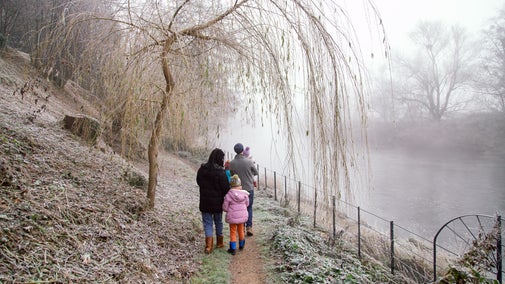Low Scrubs: A walk back in time
Oxfordshire, Buckinghamshire & Berkshire
This short circular waymarked walk takes you through the atmospheric woodland of Low Scrubs, passing relics of its ancient past from as far back as the early Iron Age.
Near to
Chilterns CountrysideStart point
Coombe Hill car park, grid ref SP851062Trail information
Waymarked walk
Look out for the orange waymark arrows mounted on wooden posts – they indicate any major changes of direction along the route.
More near here
Coombe Hill Woodland Walk
Follow this gentle circular trail in the Chilterns through beech woodland to the top of Coombe Hill, with far-reaching views from its summit.

The best of Coombe Hill walk
Take a gentle circular stroll to see Coombe Hill highlights on rare chalk grassland, with panoramic views across Aylesbury Vale and Chequers, the prime minister’s retreat.

Coombe Hill and Chequers trail
Enjoy a moderately energetic circular walk from Coombe Hill, taking in views across the Aylesbury Vale. You'll wander through woodlands, past rare chalk grassland and the pretty village of Ellesborough.

Pulpit Hill fort and nature reserves circular walk
Take in panoramic views across the Chiltern Escarpment and Aylesbury Vale, explore an Iron Age hillfort and stroll through beautiful beech woods and the Grangelands and Rifle Butts Nature Reserve.

Get in touch
Chilterns Countryside, c/o Hughenden estate, High Wycombe, Buckinghamshire, HP14 4LA
Our partners

We’ve partnered with Cotswold Outdoor to help everyone make the most of their time outdoors in the places we care for.
You might also be interested in
Things to see and do in the Chilterns Countryside
Discover the countryside sites of the Chilterns. Find the best viewpoints, walk through ancient woodland or pick a quiet spot to watch for wildlife.

Visiting Coombe Hill in the Chilterns Countryside
Explore the walking trails, play area and wildlife of Coombe Hill, the highest point in the Chiltern Hills.

Walking in Oxfordshire, Buckinghamshire and Berkshire
From gentle strolls for little legs to longer hikes through the rolling Chiltern hills, these are some of the best walks in Oxfordshire, Buckinghamshire and Berkshire.

Cotswold Outdoor: our exclusive walking partner
Learn about the National Trust’s ongoing partnership with Cotswold Outdoor. Find out how they help us care for precious places and the exclusive discount available for National Trust supporters.

Staying safe at National Trust places
The special places in National Trust care sometimes come with a few risks for visitors, be it coastline or countryside. Find out how to keep safe throughout your visits.

Follow the Countryside Code
Help to look after National Trust places by observing a few simple guidelines during your visit and following the Countryside Code.

Walking
Explore some of the finest landscapes in our care on coastal paths, accessible trails, woodland walks and everything in between. Find the best places to walk near you.

